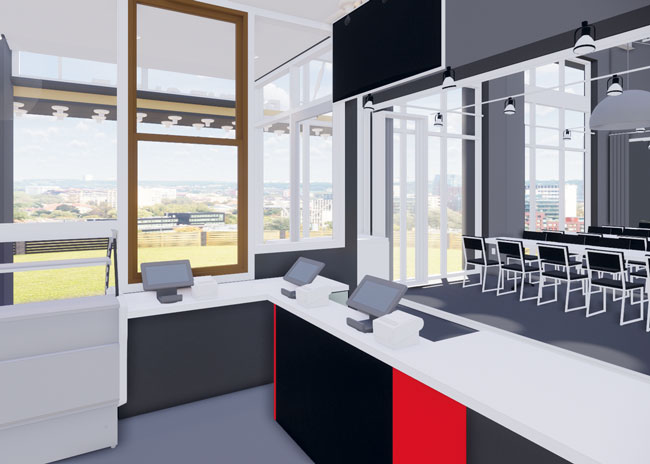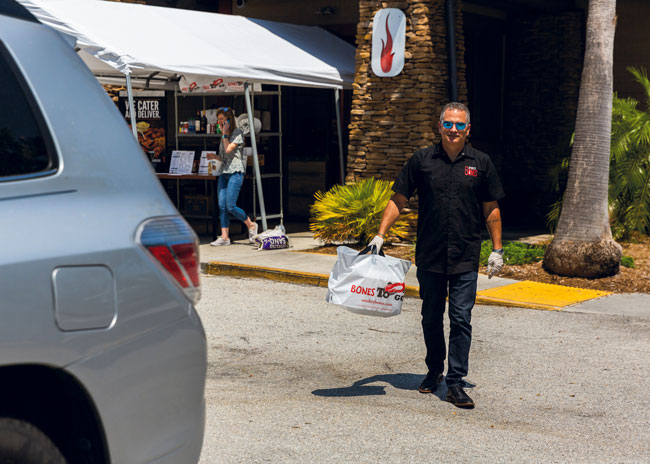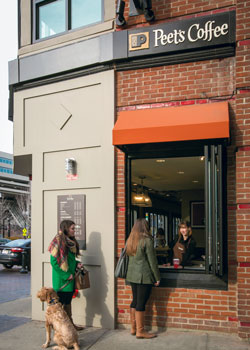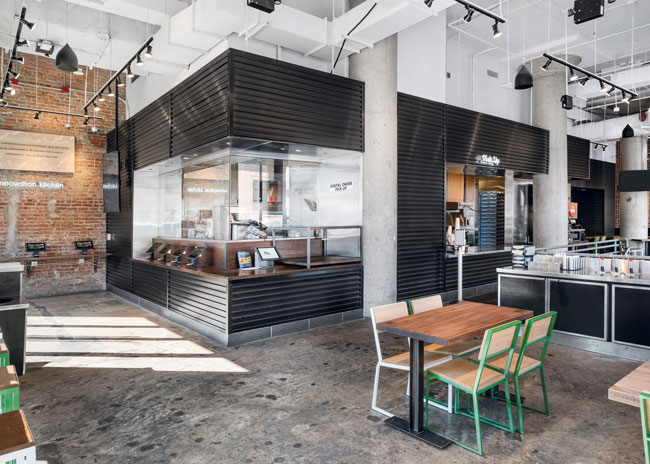While much of the discussion surrounding COVID-19 has focused on how dining room shutdowns aimed at slowing the spread of the virus also slowed the restaurant businesses, the pandemic also accelerated a variety of trends that were already in play. These trends may permanently alter the way consumers use restaurants and the way operators design going forward. Will footprints shrink, grow or stay the same? Will social distancing have a long-term impact on design? What role will technology play? Here, an operator, an architect and a designer discuss these topics as well as the overall impact COVID-19 will have on restaurant development and design.
Meet the Panel

Ed Doyle, president, RealFood Hospitality Strategy and Design:
With more than 35 years of hospitality experience, Doyle has worked in some of the finest kitchens and foodservice operations across the industry. He is a graduate of the Culinary Institute of America.

James O’Reilly, CEO, Smokey Bones:
O’Reilly joined Smokey Bones in 2019 after having served in leadership roles at Long John Silver’s, Sonic Drive-In, PepsiCo in Canada, and YUM Brands in the Caribbean, Latin America and the United Kingdom.

Zach Smith, senior architect and program lead, Bergmeyer:
Smith works with many new-to-market and emerging restaurants and has experience with chef-owned and corporate restaurant concepts. In addition to his work at Bergmeyer, Smith currently chairs the Retail and Entertainment AG Board for the American Institute of Architecture (AIA).
Social distancing has been a factor in restaurant design as operators reopen. Is it here to stay?
ZS: It’s going to be for the foreseeable future. It’s about adaptability. Unfortunately, highly designed restaurants can be a sea of tables and chairs. Is there a reemergence of private dining rooms? They had phased out a little bit, but they provide intimate experiences. Are we looking at micro-experiences within these dining spaces? That’s a future statement. That’s a significant investment in millwork and more.
JO: To a degree, social distancing is here to stay. But the idea of what social distancing means may be different a year or two from now. Right now, we are following the guidance of the CDC and the restaurant associations, which is absolutely the right decision. But as we learn more about this situation and potential treatments are developed, we will have a better understanding about how to adapt our restaurants. We will have to be faster and more flexible in our responses should this happen again.
ED: There are new startups that will have a higher preponderance of what this will look like longer term because they are making physical plans and capital investments now. Restaurants reopening will hold off on putting up new walls and barriers until they see how far the pendulum swings out there. This is as much of a business decision as it is a design decision. There is an occupancy expense, and there is an offsetting revenue per square foot that needs to cover that. Unless those two are in alignment, the business does not work. It’s not necessarily one or the other because there are ways to raise revenue in more sparse environments. But the reality is you are going to need to have flexible platforms. Can we retain a section of the dining room that allows for socially distant dining that can accommodate those customers who are still hesitant? The common thread among the successful restaurants is that they are the ones that are able to pivot and be flexible. So, the design constant will be, how do we plan for unknowns? How do we prepare to reconfigure or even “unconfigure” our spaces? I think that flexibility is going to be the constant. There will be some real creative solutions that will be real design adds.
 Private dining at Lolita Cocina & Tequila Bar Fort Point. Image courtesy Richard Cadan Photography
Private dining at Lolita Cocina & Tequila Bar Fort Point. Image courtesy Richard Cadan Photography
Will restaurant footprints shrink, stay the same or grow?
ED: I think it’s a space allocation question versus square footage. If we designed a fine-dining restaurant a year ago and asked the chef where he wanted takeout to go, he would have thrown us out. But now it’s become a question about how you configure things to manage that properly. How do we enable these third-party platforms to come in and not gum up the host stand? I don’t expect it to be bigger or smaller, but people think about how they allocate square footage to indoor dining. So maybe the kitchen gets to become bigger than 30% of the total space because we have a ghost kitchen running and we’re doing well with takeout. As a result, maybe the dining room becomes smaller.
ZS: It’s a program shift, and it’s a reallocation of space. Restaurants need to make money with every square foot. So, it’s just a matter of how they make that money. One area that will get radicalized is the QSR. I can see their dining rooms getting smaller and kitchens getting bigger as they get even more takeout as web-based or app ordering grows. I think ghost kitchens are pretty interesting, too.
JO: Casual-dining restaurant footprints will likely shrink, because I anticipate a shift in how guests will patronize our restaurants. Off-premises sales will become a bigger part of the equation for casual-dining concepts like Smokey Bones. To maximize returns, casual-dining operators will need to adjust their footprints accordingly. At Smokey Bones, for example, we committed to making off-premises a growth strategy back in 2019 when we formed a new management team. We see technology as an enabler of that, too. What’s happened due to the coronavirus — those trends have been accelerated. We will put that learning into practice in the form of smaller-footprint restaurants. One trend we saw before the coronavirus was the way casual-dining guests were using technology to get higher-quality food to their homes or workplaces more frequently than they were two to four years earlier. So, with third party, we have a way to get that food to guests and customize that experience for them.
ED: You will see more exterior interface, like lockers where guests can pick up their food without ever entering the space or through-the-wall delivery, where the lockers back up to the kitchen and staff just place the orders in that space. You will see more restaurants considering drive-thru, too. When serving customers who order ahead and come to pick up their food, I don’t think the shelf with a bag on it is going to fly anymore. How are you going to deal with people touching your food? You have to design for the most fastidious customer that will come through your door. It needs to be a conscious decision, and it goes right down to the staff.
What role will ghost kitchens play in the future of restaurant development?
ZS: Ghost kitchens have been acting more like commissary or catering kitchens until now. In fine dining, how do we take these experiences and make them suitable to go? All of our kitchens flow one way: back to front. How do you flex these kitchens to handle off-site? It’s an interesting question to see how they fit into the overall puzzle.
ED: The whole idea for ghost kitchens came from third-party apps and the ability to generate incremental revenue without adding too much more labor. The bigger question is, what’s going to happen with these third-party apps? There are going to be smarter operators that look at where every cent is going. A third-party delivery app is great so long as it is bringing you new customers and fits within your existing labor model. There is going to be a conversation within the ghost kitchen environment about how we achieve delivery or a new user interface because the financials are so slim.
 To limit the amount of foot traffic in restaurants and other foodservice operations, RealFood Hospitality Strategy Design suggests concepts consider adding walk-up windows where possible.
To limit the amount of foot traffic in restaurants and other foodservice operations, RealFood Hospitality Strategy Design suggests concepts consider adding walk-up windows where possible.
James, how do ghost kitchens play into Smokey Bones’ future plans?
JO: The vision for the off-premises strategy became “Smokey Bones anytime, anywhere.” In practical terms, a restaurant guest in downtown Chicago is not concerned whether there’s a freestanding Smokey Bones nearby. They want to have a good barbecue experience in their home or office. So, having partners in Kitchen United is a great extension of our strategy. We intend to extend our brand through the use of ghost kitchens.
In the past, traditional industry observers felt it would be difficult for an operator to enter a market with only a ghost kitchen. Similar to the old debate: Which came first, the chicken or the egg? Has the thinking changed?
JO: I believe there is a parallel in the way restaurant operators think about development. Opening ghost kitchens where there are existing restaurants should generate a higher return on investment given the lower cost of adding the virtual space. But moving into an area where the brand does not exist will require a higher investment to build awareness. That does not necessarily invalidate that line of thought. To me, it’s not the chicken or the egg — it’s the chicken and the egg.
This connects back to how hospitality will continue to evolve.
ZS: I had a conversation with a chef [who thinks that] even if the food comes out of his kitchen, it is competition for his front of house. So, he does not want people outside of his restaurant to have his food. Is this OK, or is it something he needs to move on from?
ED: We need to get comfortable with the idea that we deliver hospitality outside of our four walls. Some of that is in design. We are going to see vast improvements in packaging design so we can see an elevated takeout experience. The power dynamic has shifted. We now need to accommodate the needs and wants of the customers more so than before. We used to create perceived value in those physical touch points. Every one of those tactile points has become a liability. So, we now have to ask, what are the value triggers?
 To weather the pandemic, Smokey Bones added curbside delivery to its offerings. In the future the chain may add a special entry where takeout customers can pick-up their orders. Image courtesy Smokey Bones
To weather the pandemic, Smokey Bones added curbside delivery to its offerings. In the future the chain may add a special entry where takeout customers can pick-up their orders. Image courtesy Smokey Bones
Looking to the future, how do you think our restaurant experiences will be the same? Different?
JO: As a consequence of a permanent shift of some consumers from dine-in to at-home consumption, successful casual-dining operators will curate guest experiences in more focused ways to ensure they can protect and grow their share of the dine-in market segment. This should lead to an improvement in overall dine-in restaurant experiences in the casual-dining segment. It started with the changes in guest behavior, and we have to pay attention to the experiences the guests want to have around food. As we look at guest behavior, sentiment and the like, we anticipate shifts. They will want to have more high-quality food in their homes with their families.
ED: Digital engagement will be critical. Understand that your brand is not your logo. From pre-engagement to post-engagement, it needs to be a seamless brand experience. This applies to everything from your app to your bag. If you reopen a restaurant that never offered takeout but now does, how do you make that experience seamless without it feeling like a bolt on? What are we doing to control that brand experience outside our four walls to provide hospitality?
ZS: There’s some harkening back to those hospitality roots in the form of high levels of service. Make that front-of-the-house operational level really special. Make that as much of the attraction as the physical environment.
As the way restaurants provide guest experiences changes to meet their evolving expectations, how does the restaurant infrastructure evolve?
ED: That’s the million-dollar question. We have always evolved as an industry. We need to listen to different cues that are driving the evolution. We need to listen to things we have never thought of before. We need to design in a way that lets us evolve and not limit our options. I don’t want to solve for COVID-19. I want to address the next six things we have not thought of yet. We need to create a flexible, modular design that allows us to reconfigure our spaces, to pivot to the way guests want to use our restaurants. We have to create more flexibility. We can’t be dogmatic. We need to have a global view and understand what’s happening in other segments and how it applies to the restaurant.
JO: The restaurant infrastructure needs to be reevaluated in two different ways: design and technology. We will invest in technology that puts the guest in more control than in the past. Given the shift to more off-premises, it’s incumbent upon us to make sure the on-premises experience will be executed at an even higher level than before so when guests do choose to dine in our restaurants, they have an incredible experience and will feel rewarded.
ZS: Our firm does a lot of retail work, and retail has gone through a lot of this the past five to ten years as stores and malls have experienced some significant changes. As a result, retailers have gone digital. Retail has seen a lot of that disruption, and restaurants can learn a lot from it. A lot of the new retail concepts are online first, and it becomes experience first in the stores. I think that approach would be interesting for restaurants to start exploring. Having markets in your restaurants and selling some of your ingredients can be another interesting avenue for restaurants to explore. Maybe that’s just exploding the restaurant experience as we think of it?
ED: My hope is that if there’s anything that comes from COVID-19, it is that we don’t race to get back to the old normal. We need to use this as an opportunity to reset our industry to allow it to be far more sustainable, make delivery an elevated experience to our guests, create great workspaces for our employees and deliver tremendous value to people that come into our space. We as an industry need to think about what we do and why we do it and what sustainability looks like in every element. It’s an opportunity I hope we don’t squander.
 For restaurants with app ordering, such as Peet’s Coffee, adding walk-up windows may become a natural part of its design where appropriate. Image courtesy Carly Gillis PhotographyHow will the restaurant of the future differ from the restaurant of today?
For restaurants with app ordering, such as Peet’s Coffee, adding walk-up windows may become a natural part of its design where appropriate. Image courtesy Carly Gillis PhotographyHow will the restaurant of the future differ from the restaurant of today?
ED: Think about when we got rid of tollbooths. People fought to keep them, but why would you have a tollbooth anymore? At the time, it seemed like a bridge too far. If we really try to innovate and un-anchor ourselves from the past as we try to think about what we want to create, it will be different. The segments of our industry will continue to exist, but the users will interact with them differently. And hopefully, how we deliver that experience will continue to evolve. We won’t get 10 years down the road and be unrecognizable. People are still going to want to have a relationship with their restaurant. The goal is to establish a relationship with the client while being flexible enough within your concept to allow customers to interact with your brands in different ways. Every touch point reinforces that. Otherwise, it becomes transactional.
JO: The restaurant of the future will have a dedicated entry and exit for the off-premises guest. This way, the experience is consistent with their need for speed and convenience. Plus, this ensures our on-premises guests will have a good experience. There will be dedicated parking for both sets of customers. Until recently, the two types of guests had become intertwined in casual dining. There will also be a more finely curated experience for the on-premises guest. We’ve done a lot of research to understand what our guests value the most about the Smokey Bones experience. It starts with the way we prepare our proteins and includes a very vibrant bar experience, and it includes a high-quality experience with our highly trained teams. The Smokey Bones of the future will be stronger and more focused around that brand experience for the guest.
ZS: It’s a whole new approach. It’s looking at other industries that have dealt with this level of change. They had to pivot to deal with the disruptor that came in and rewrote the book. It’s somebody from outside the restaurant industry that will come in and say,
“This can be done differently.”
What’s something you would happily wave goodbye to with regard to restaurant or foodservice design?
JO: Credit card payment terminals. Virtually every guest that walks through the front door carries better technology than we could put into our restaurants, and they are very comfortable using it. As we move forward, we will look to leverage that in allowing them to utilize technology and devices they are most comfortable with. So, we see contactless ordering and payment as part of the future.
ED: I would like to wave goodbye to things people think they have to do. I am not talking about regulatory- or safety- or health-related things, but those items people feel they have to do because it’s expected. We need to carve out our own space, deliver an experience we can truly own and make sure it’s truly intentional.
ZS: The traditional dogmatic ways restaurants take with them. Have open eyes to new approaches. We are seeing that with people who are more successful now than they were pre-COVID-19. For example, there’s a brewery around here where you used to have to go to their location to get their beer, and now they will drive it to your doorstep. That’s opened up a whole new market for them. From these awful tragedies come opportunity.
 Restaurant chains like Shake Shack will leverage a combination of technology and walk-up windows in their design strategy moving forward. Image courtesy Chase Daniel Photography
Restaurant chains like Shake Shack will leverage a combination of technology and walk-up windows in their design strategy moving forward. Image courtesy Chase Daniel Photography



